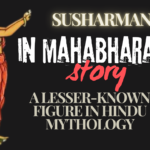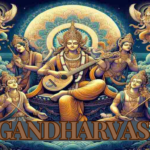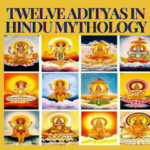The Gandharvas are a fascinating group of celestial beings rooted in ancient Indian mythology and Vedic literature. Known as divine musicians, the Gandharvas have been depicted in various texts and traditions, including the Vedas, the Mahabharata, the Ramayana, and the Puranas. These celestial entities have captivated the imagination of scholars and spiritual enthusiasts for centuries. In this article, we delve deep into the world of Gandharvas, exploring their origins, roles, characteristics, and their cultural significance.
Who Are the Gandharvas?
The term “Gandharva” originates from Sanskrit and is often translated to mean “fragrance” or “heavenly musician.” In Hindu mythology, Gandharvas are considered semi-divine beings who inhabit the celestial realms. They are closely associated with music, dance, and the arts, serving as the entertainers of the gods. Gandharvas are also known for their association with love, sensuality, and marital rites. They are frequently described as having a dual nature—both divine and somewhat mischievous.
Gandharvas are traditionally depicted as male, while their female counterparts are known as Apsaras. Together, they reside in the realm of Indra, the king of gods. They are skilled musicians, and their melodies are believed to enchant not only gods but also mortals. Beyond their roles as entertainers, Gandharvas serve as messengers between the gods and humans, acting as intermediaries in the divine realm.
Origins and Mythological Significance.
The Gandharvas have their origins in the Rigveda, one of the oldest known texts in human history. In the Vedas, they are described as spirits who guard the Soma, the divine nectar of immortality, and are often seen as protectors of the sacred. According to some interpretations, Gandharvas are born from the cosmic egg, the Hiranyagarbha, or are considered offspring of Brahma, the creator god.
In the epic Mahabharata, Gandharvas play various roles. The great warrior Arjuna, one of the Pandavas, is said to have learned the art of music and dance from Chitrasena, a king among the Gandharvas. Gandharvas are portrayed as divine beings with supernatural powers, capable of casting illusions and engaging in battles with mortals when necessary.
According to the Puranas, the Gandharvas were created during the cosmic process of creation to fill the heavens with music and joy. They are also seen as the protectors of the heavens and guardians of divine treasures. Their role often extends to being protectors of sacred knowledge and divine rituals.
Characteristics and Depictions of Gandharvas.
Physical Appearance.
Gandharvas are described as strikingly handsome beings with radiant complexions. They are often adorned with garlands of flowers, and their bodies emit a celestial fragrance. Gandharvas possess wings, which enable them to travel swiftly between the heavens and the earth. Their physical attributes reflect their connection to beauty, grace, and artistry.
Musical and Artistic Prowess.
One of the most distinguishing features of the Gandharvas is their unparalleled musical ability. They are the celestial musicians, often depicted with musical instruments such as the veena, flute, or drum. The music of the Gandharvas is said to have the power to bring peace, heal wounds, and inspire creativity. They are also known for their skills in dance, often performing in the celestial court of Indra to please the gods.
Role in Marital Rites and Love.
The Gandharvas are also associated with love and marriage in Hindu tradition. A form of marriage known as Gandharva Vivaha is named after them. This type of marriage is based on mutual attraction and love between two individuals, without formal rituals or societal consent. The concept is believed to be inspired by the free-spirited and romantic nature of the Gandharvas.
Gandharvas in Different Cultures and Texts.
The concept of Gandharvas is not limited to Hinduism; they also appear in Buddhist and Jain traditions, albeit with some variations in attributes and roles.
In Buddhism.
In Buddhist texts, Gandharvas are considered to be spirits that live in the sky and serve the Devas (gods) with their music. They are seen as a type of demigod who also plays a role in the cycle of life and death, guiding the souls of the deceased to their next birth. The Buddhist Gandharvas are often depicted as more benevolent and less mischievous compared to their Hindu counterparts.
In Jainism.
In Jain cosmology, Gandharvas are included in the category of “Vyantaras,” one of the four classes of gods. They are considered to be celestial beings who live in a different plane of existence and are responsible for music and entertainment in the heavens. Unlike Hindu and Buddhist interpretations, Jain Gandharvas do not typically interact with humans or participate in earthly affairs.
Modern Interpretations and Cultural Significance.
Gandharvas continue to inspire modern literature, music, and art. They are frequently referenced in Indian classical music and dance, where the concept of divine inspiration is often attributed to these celestial beings. Gandharvas are also mentioned in contemporary literature, films, and television shows, symbolizing the connection between the divine and the mortal, the artistic and the spiritual.
In addition, Gandharvas are seen as symbols of freedom and artistic expression. Their association with love, beauty, and music makes them a timeless archetype in the cultural consciousness of South Asia and beyond. Their legacy continues to evolve as they are reinterpreted through the lens of modernity and globalization.
The Spiritual Role of Gandharvas.
From a spiritual perspective, Gandharvas are seen as guardians of the arts and protectors of sacred rituals. Their music and dance are considered divine offerings to the gods, and they play a crucial role in maintaining the cosmic balance. In Vedic rituals, invoking the blessings of Gandharvas is believed to bring prosperity, happiness, and peace.
Meditative and Healing Qualities.
Many practitioners of yoga and meditation invoke the Gandharvas for their healing qualities. It is believed that the music of the Gandharvas has the power to elevate consciousness, heal emotional wounds, and promote inner peace. In certain spiritual practices, the presence of Gandharvas is invoked to create a sacred space for meditation and prayer.
The Gandharvas are a fascinating aspect of Indian mythology, embodying the blend of divine artistry, love, and spiritual significance. Their multifaceted roles as celestial musicians, protectors, and messengers make them one of the most intriguing celestial beings in the mythological universe. The legacy of the Gandharvas continues to captivate the imagination, resonating with those who seek to understand the mysteries of the cosmos.





